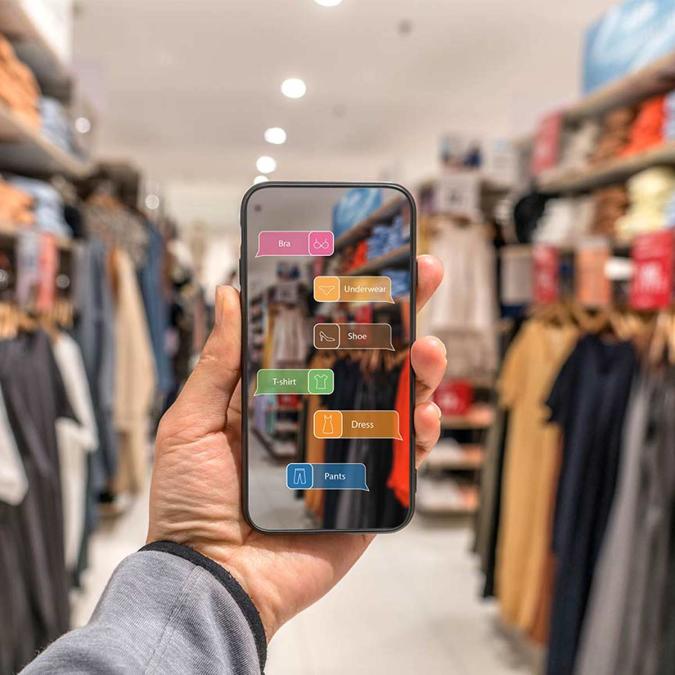Our new digital retail whitepaper has been published revealing what today’s shoppers really want to see from retailers. Top of the list includes digital innovation in-stores and a better alignment of online and offline experiences.
Retailers looking to improve their commerce strategies may be interested in some new research which has been collated by digital retail specialists, Sherwen Studios. The firm, who have worked with national retail brands such as ScS and Booker, have published a comprehensive whitepaper, titled “Bricks and mortar stores vs. online retail. How to combine online and offline experiences to improve shopping for your customers”.
The research report (which is available to download in full from the Sherwen Studios website) has delved into what customers really want to see from retailers over the next few years. By questioning over 2,000 shoppers about their shopping habits and preferences, Sherwen Studios has identified five clear areas for improvement for retailers operating online and in physical stores.
These include:
Social Commerce
Customer Service
Search Capabilities
Improving the checkout process
Diverse delivery options
Sherwen Studios has discovered that shoppers are unconcerned with the implementation of CGI marketing, artificial intelligence, and other augmented reality tools within websites unless they are used for a distinct purpose. Instead, shoppers would prefer retailers to focus their strategies (and their budgets) on ways to digitise retail outlets and improve the overall shopping experience.
Customers are particularly keen for retailers to facilitate a seamless transition between online and offline sales. Key bugbears for customers including automated chatbots which do little to improve the online experiences, complicated payment options and different pricing structures online and in-store.
It’s imperative that any eCommerce strategy continually asks the question ‘what do our customers want?’ Too many retailers base their eCommerce strategies on the latest trends and technical capabilities rather than what customers actively want. As a result, they get caught up in the possibilities of what can be done without thinking about who their audience is. This could result in retailers implementing the wrong solutions – and that will never lead to an effective return on your investment.
CEO, Sherwen Studios, Matt Sherwen
Here are three key takeaways from the white paper.
1. Digitising retail stores could dramatically increase sales.
The biggest discovery from the white paper, is that retailers can make better of use of simple technologies, such as QR codes to make quick and easy digital improvements in-store which could effectively align your online and offline sales. Today’s shoppers want to enjoy a stronger social commerce experience.
They want to be able to share recommendations with friends, they welcome the flexibility and ease of online wish lists, and they want to be able to remember items that they’ve seen in-store. When questioned, 40% of respondents (rising to 63% of those aged 16-24) said that they would actively increase their purchasing in-store if QR codes became more mainstream. In today’s competitive retail market, this increase in purchasing opportunities is something that retailers simply cannot ignore.
The flexibility of the QR code shouldn’t be overlooked by retailers. They offer a seamless way of integrating your online and offline sales. Customers could scan QR codes on a product label to log into their online accounts and save to wish lists or they could use a QR code to check if an item is in stock. They could even direct customers to additional information about the product and how it is used. Such a small adjustment could make a significant improvement on a retailer’s bottom line.
CEO, Sherwen Studios, Matt Sherwen
2. Shoppers have changed the way that they use retail websites.
Despite continual fears over the death of the high street, Sherwen Studio’s white paper provides some hope for retailers who operate online and offline. The white paper confirms that a third of all shoppers (32.21%) have “previously browsed online with the intention of completing their purchase in-store”. This contrasts to just 15.25% who have “taken up the time of a shop assistant in-store and purchased online elsewhere.” This may signify that retailers should look at how they can amend their websites and online shopping platforms to offer greater inspiration and recommendations.
From our research we’ve learned that customers want to be inspired by retail websites. They are being used for browsing, education and inspiration as much as they are for purchasing transactions. This tells us that retailers need to look carefully at their websites to see how they can offer improvements that meet these needs.
CEO, Sherwen Studios, Matt Sherwen
3. Customers want a better alignment between online and offline shopping experiences.
A final key takeaway from the white paper is that customers are frustrated by the disparities between the shopping experiences of brands online and offline. The biggest frustrations occur when shoppers find pricing differences on the same product, with many retailers offering voucher codes or time-limited discount deals to drive online sales. 25% of shoppers confirmed that price differences between online and offline are what they like least about shopping in a physical retail outlet.
Beyond the pricing differences, shoppers also confirmed that they want to see replicated payment options online and in-store. While online retailers have implemented buy-now, pay later options such as Clear Pay, Klarna and PayPal into their checkouts, physical stores have been slow to integrate these new payment options into their systems. Yet 40% of shoppers would be "much more likely" or "somewhat more likely" to make a purchase in-store if these payment options were in place.
Today’s shoppers expect to have the same shopping experience online and offline. It’s important that retailers set cohesive expectations; if there is a dramatic difference, it could cause a shopper to have a negative experience and choose to shop elsewhere.
CEO, Sherwen Studios, Matt Sherwen
To read more about how retailers can combine online & offline shopping experiences and discover practical suggestions that can have a significant impact on their bottom line, please read our whitepaper.
